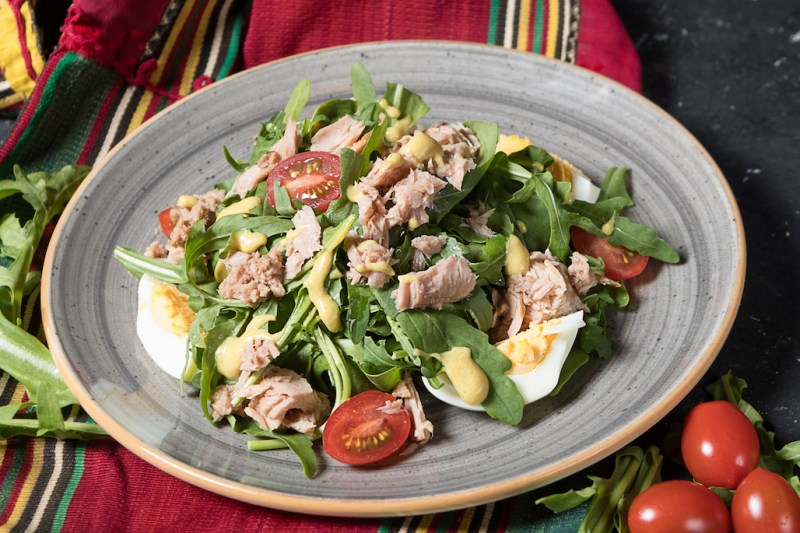Tuna, a firm-fleshed fish that’s available in budget-friendly cans to high-end sushi, is also a superfood. From a nutritional standpoint, tuna is a treasure-trove, containing plenty of protein, vitamins, and healthy fats. As a bonus, tuna is also a flexible ingredient that’s tasty both raw or fresh off the grill.
To navigate tuna’s many health benefits, The Manual has sought out the guidance of Rima Kleiner. A registered dietitian and a licensed dietitian and nutritionist, Kleiner is also the creator of the food blog, Dish on Fish. With a focus on highlighting seafood, Dish on Fish provides recipes and health advice with a pescatarian spin. Kleiner’s mission is simple — encourage people to eat more seafood, an element she considers a critical part of a healthy diet.

Besides the blog, Kleiner also has an e-cookbook, “Everyday Seafood Recipes: 65 Quick & Easy Dishes.” This fun cookbook is filled with original, primarily pescatarian recipes that are great for any home cook looking to expand their seafood repertoire.
Related Guides
- The 10 Best Canned Tuna for a Healthy and Convenient Meal in 2021
- How to Sustainably Shop for Seafood, Made Simple
- Where to Buy the Freshest Seafood Online
The Nutritional Benefits of Tuna

One of the best health benefits of tuna is its high protein content which is needed for proper workout recovery. All seafood, from anchovies and salmon to lobster and crab, feature high quantities of protein. But according to Kleiner, tuna is a level above, containing a higher protein content than other types of fish (certain tuna species like bluefin and yellowfin are especially high.) Protein is important for the body because it aids the brain in recognizing the hormone leptin. This hormone is not only an excellent source of energy, it also makes people feel fuller for longer periods of time.
“If you are working out to lose weight, protein also helps your body in huge ways! Low fat, high protein foods, like salmon, give you the strength you need to power through a workout,” said Kleiner.
Besides protein, fatty fish like tuna is also an awesome source of omega-3 fats and vitamin D. Omega-3s are known for their anti-inflammatory properties as well as aiding heart, bone, eye, and skin health. One surprising benefit is sleep. Omega-3s fats are believed by some experts to improve sleep quality and quantity in adults and children. This is achieved because omega-3s can help stimulate melatonin, a hormone that aids the sleeping process. In 2017, a study concluded that adolescents who regularly ate fatty fish experienced two remarkable developments — improved sleep quality and increased IQ scores. Tuna’s sleep quality benefits also extend to vitamin D because of its ability to promote a healthy circadian rhythm. As a plus, vitamin D also boosts bone health and the immune system.
However, tuna’s health benefits aren’t done just yet. This fish also contains plentiful amounts of vitamins B-12, selenium, and zinc. Vitamin B-12 is believed to support DNA and red blood cell production while zinc and selenium are stellar at promoting a healthy immune system.
Canned Tuna vs Fresh Tuna

So how should one consume this healthy fish? Are there any differences in nutritional value between canned and fresh? What should a buyer look for when purchasing these options? After all, fresh tuna can be prohibitively pricer than the canned version.
The truth is there isn’t a huge nutritional difference between canned and fresh tuna. Although fresh tuna will have a slightly higher protein content along with no carbohydrates, canned tuna actually features mostly the same amount of vitamins and nutrients. A key difference is the species of tuna. Most commercial brands of canned tuna are made from cheaper skipjack or albacore tuna species. For fresh tuna preparations like sushi or grilling, bluefin or yellowtail are the primary species. Canned tuna will also vary in calories depending on whether it’s packed in oil or water, with oil having a higher calorie count.
Another difference between the two versions comes down to taste preferences, recipes, and storage. Fresh tuna is best seared or grilled still raw in the middle. If served completely raw, tuna will usually appear as sushi or carpaccio. On the other hand, canned tuna is extremely flexible, equally great in salads and sandwiches as well as creative recipes like Korean kimbap rice rolls. Shelf life is another bonus for canned tuna. If unopened, a can of tuna can be stored at room temperature for long periods of time. One thing to know is that higher-quality versions of canned tuna will usually be jarred. These jarred tunas are made with large chunks of fish preserved in olive oil. Although jarred tuna is more expensive, the flavor and texture are superior to canned, which can sometimes be too shredded.
The Sustainability of Tuna
One thing to consider when purchasing tuna is sustainability. Unfortunately, many tuna species are threatened by overfishing and environmental damage. This makes shopping for the right brand of tuna particularly important for the conscientious consumer.
To shop sustainably, pay attention to the label MSC (Marine Stewardship Council Fisheries Standard) and the words pole-and-line-caught and FAD-free. All of these indict sustainable fishing practices that are designed to be less invasive, avoiding the large industrial fishing that damages the ecosystem. Some great jarred tuna brands include Genova or Tonnino, which are also packed in heart-healthy olive oil for an extra nutritional boost. For a great canned option, try Wild Planet Albacore Wild Tuna, a pole, and line caught tuna with no added oils or fillers.
Editors' Recommendations
- 12 delicious foods high in vitamin E for skin, hair, and heart health
- Study reveals another great reason to follow the Mediterranean diet (that has nothing to do with your health)
- These foods are high in soluble fiber and vital for good health
- 5 ways a high-protein diet benefits your health
- 11 fantastic foods that are high in fat and low in carbs to support your health




